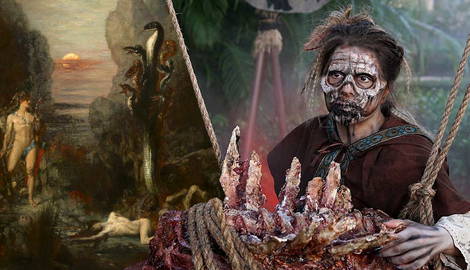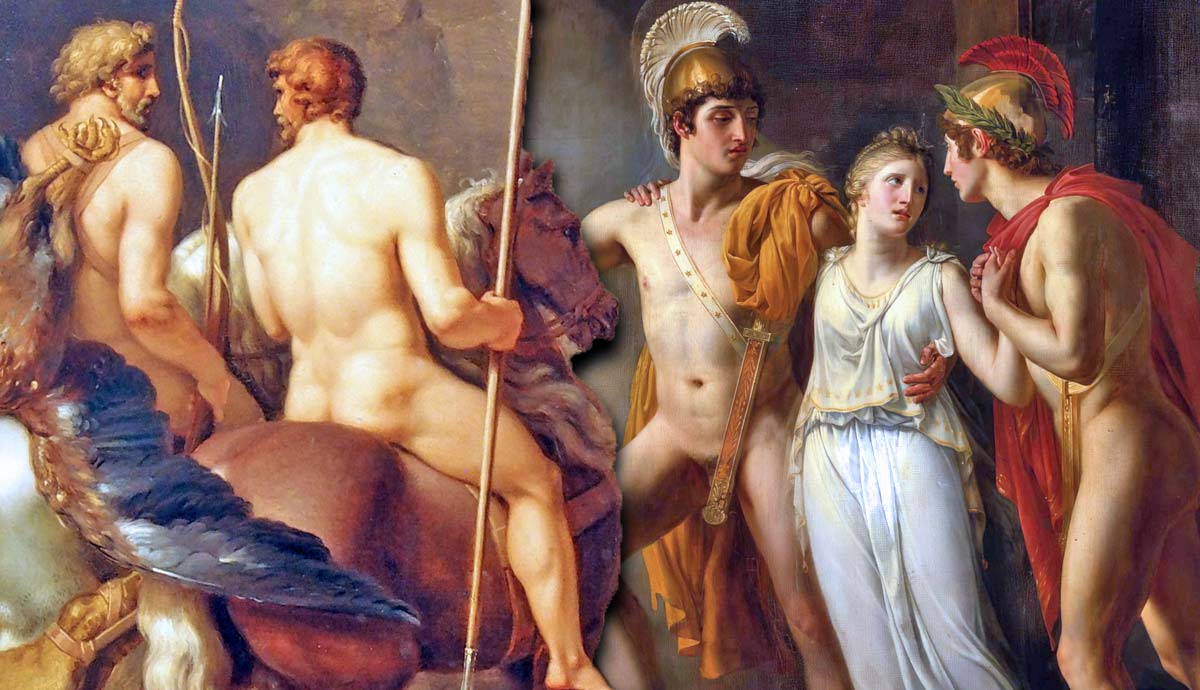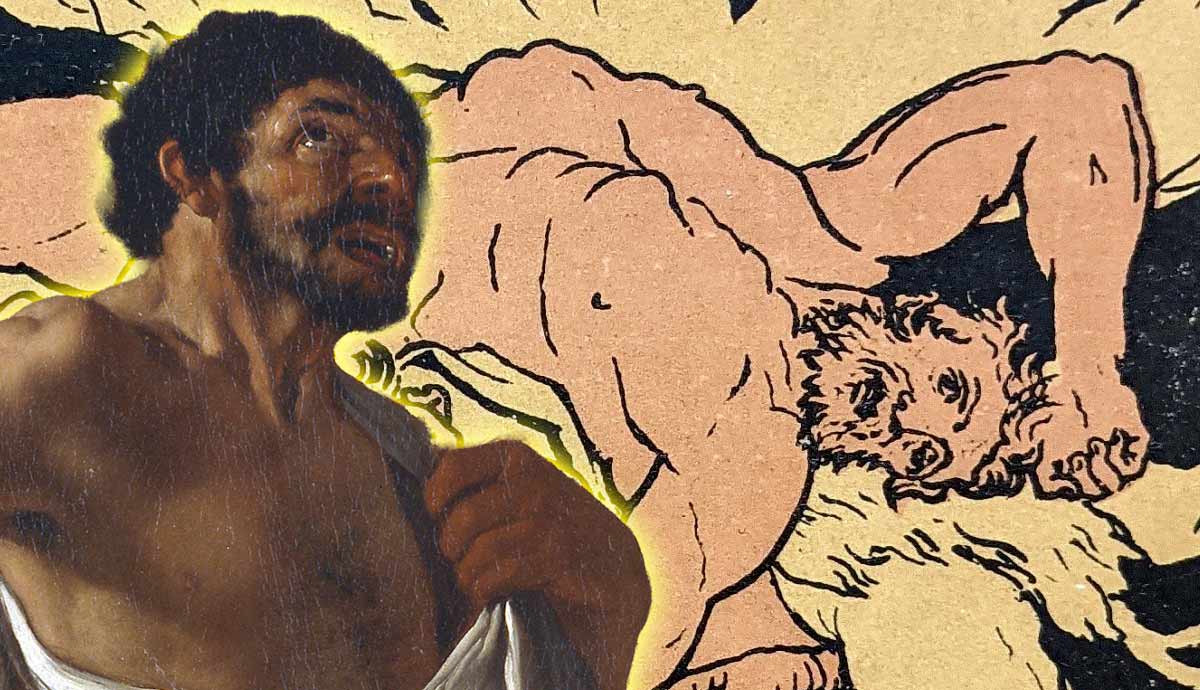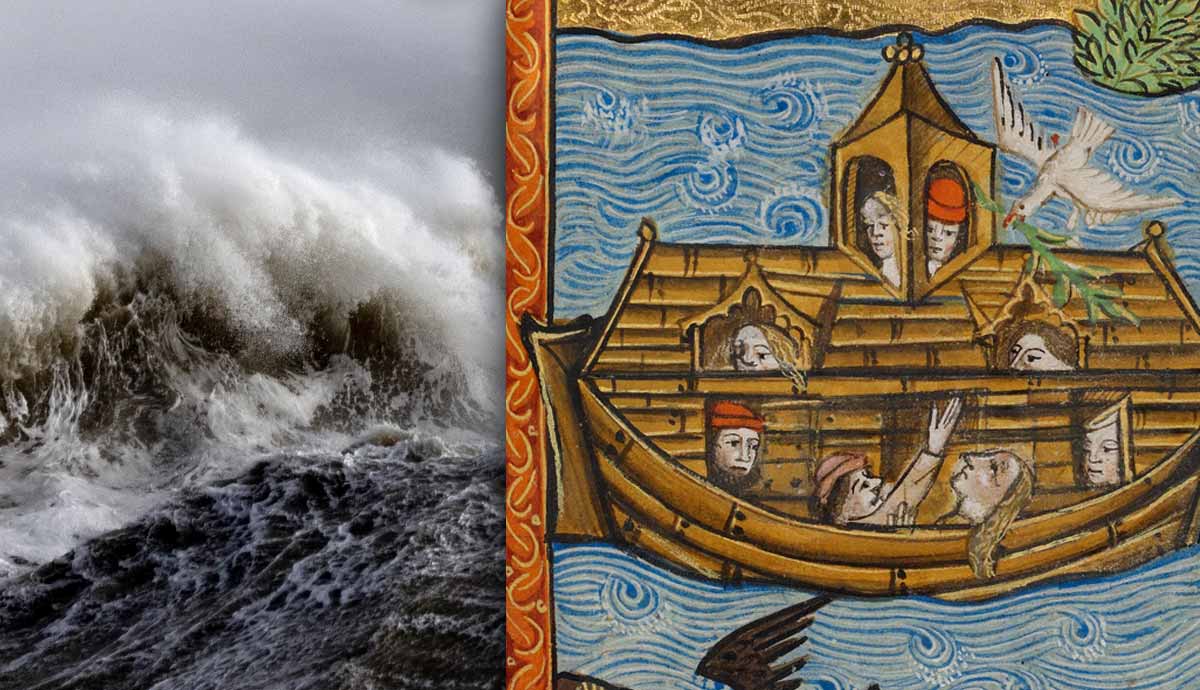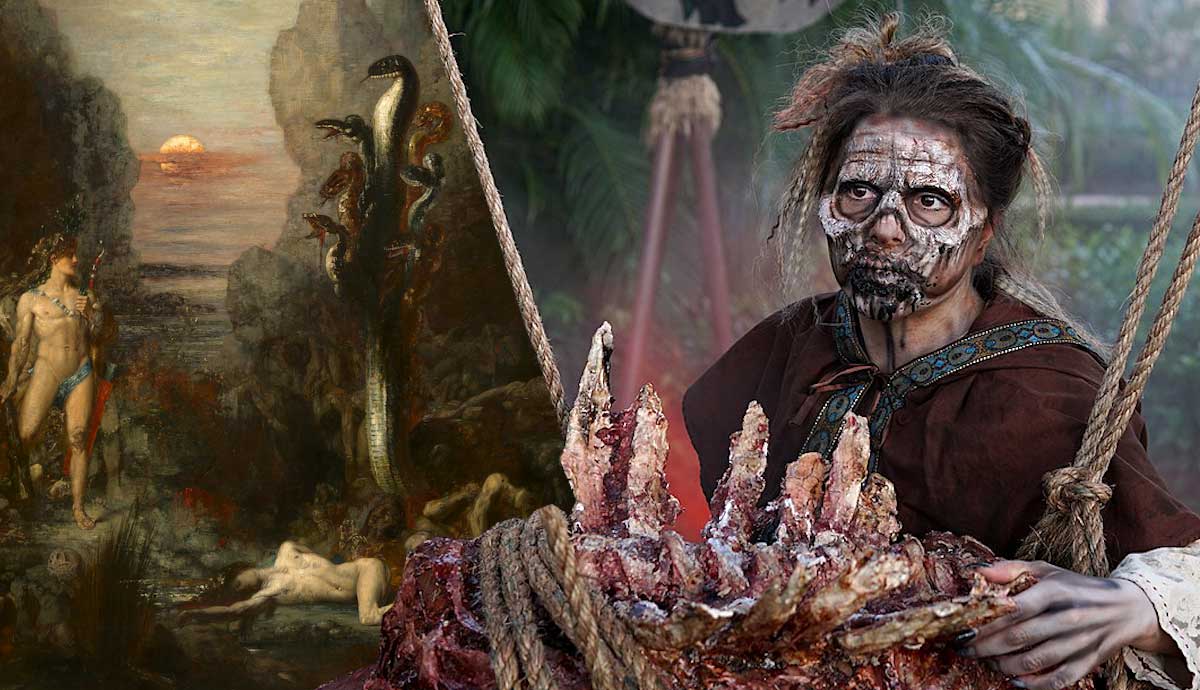
Every culture across time has told stories of fantastical, mythical creatures. Some are described as wondrous and incredible, while others occupy a darker, more terrifying place in the imagination. The purpose of these darker mythical creatures is seemingly to wreak havoc and destruction, strike fear, torment their victims, and commit inhumane atrocities. These horror myths are strangely appealing, drawing on fears and insecurities inherent in human nature and sometimes acting as cautionary tales. Let’s look at 16 of the most terrifying mythical creatures from around the world.
1. Jorogumo: Terrifying Japanese Spider Seducer

In Japanese mythology, a Jorogumo was a deadly hybrid creature that could transform from a spider into a beautiful woman to seduce and kill its victims. The story goes that when a Jorogumo spider, a common species found in Japan, reached 400 years, it gained the power to shapeshift and developed an appetite for human flesh.
Disguised as beautiful women, these creepy creatures were able to enchant and lure men into their web of lies. Their webs were constructed of silk threads so robust that, once trapped, no man could escape. According to Japanese folklore, the Jorogumo would then administer its lethal venom, gradually weakening its victim, to savor its prey as long as possible. A slow and painful demise for their sorry victim.
2. Gashadokuro: Skeletal Giant of Japan

Gashadokuro are gigantic mythological creatures amalgamated from the bones of human skeletons in Japanese mythology. In situations of mass death, such as famines or wars, individuals could not receive proper funeral rites. That mean that they were unable to move on after death. As their bodies decayed, their souls became twisted with wrath and resentment towards the living. Their souls and bones merged into one enormous being called a Gashadokuro, translated as the “starving skeleton.”
Terrifyingly silent, aside from the unnerving chattering of their teeth, these mythical creatures skulked around deep in the night, looking for prey. Finding their victim, they decapitated them and drank their blood. A Gashadokuro would continue terrorizing the night until the resentment of every soul residing within the creature had dwindled, no longer animating the skeletal monster.
3. Penanggalan: Malay Disembodied Vampire
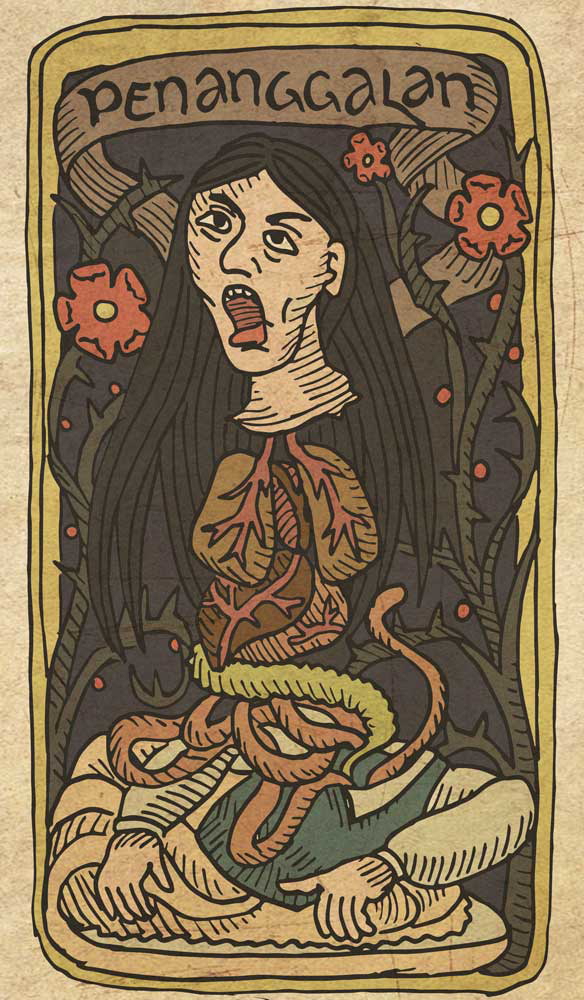
Penanggalan are infamous mythological creatures known by different names throughout Southeast Asia. In Malay myth, a Penanggalan was once a mortal woman who performed witchcraft and black magic.
A popular version of the myth states that one woman agreed to become a vegetarian for 40 days in exchange for youthful beauty. Ultimately, she broke her pact and was cursed to become a flesh-eating Penanggalan. During the day, she resembled an ordinary woman, but at night, her head would detach from her body, floating around with her trailing entrails. This disembodied figure flew around searching for sustenance in the form of pregnant women and infants, draining them of their blood. Those fed on by this vampiric creature ended up contracting a fatal disease. Returning to her abode, a Penanggalan would soak herself in vinegar to shrink her organs back into her body. A Penanggalan, therefore, could be recognized during the day by this tell-tale smell of vinegar.
4. Lamashtu: Mesopotamian Mother of Demons
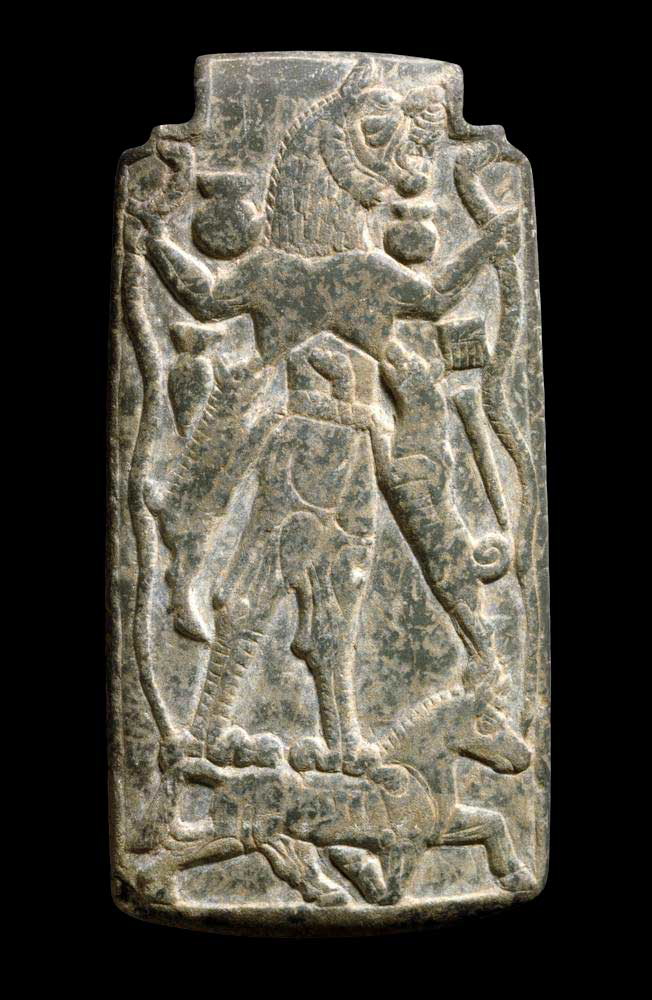
The demon goddess of Mesopotamian mythology, Lamashtu, was a hellish hybrid creature usually depicted as pregnant, covered with thick hair, and with two skulls over her breasts, a snake’s tail, large wings, three eyes, and taloned feet. The head of this beast was said to be either a jackal, lioness, snake, or hawk, depending on the source.
Lamashtu was known to enact destruction by polluting nature and water, spreading disease, causing nightmares, as well as drinking the blood and devouring human flesh. She is said to have especially terrorized pregnant women and children. The demoness would force miscarriages to occur and kidnap infants, feeding them with her own poisonous milk before chomping on their bones and satisfying her thirst with their blood. Lamashtu herself was considered the mother of many demonic creatures and monsters who carried out her malevolent bidding.
5. Ammit: Egyptian Devourer of the Dead

In Ancient Egyptian mythology, Ammit was a beastly goddess with the head of a crocodile, the frontal body of a lion, and the rear of a hippopotamus. Known as the “Devourer of the Dead,” Ammit fulfilled a particularly gruesome role in the judgment of souls. In the underworld, Thoth would weigh the heart of an individual against the feather of Ma’at, the goddess of truth.
The scales remained balanced if the individual was pure, but would be tipped if this was not the case. A heavy heart meant that the person was unworthy of eternal bliss. These hearts of the impure were thrown to Ammit. The beast, devouring their hearts, would ensure that these souls ceased to exist forever. This was the worst fate in a culture focused on life after death.
6. Typhon: Greek Monster of Monsters

In Greek mythology, Typhon was regarded as the fiercest, deadliest, and biggest of giants, monsters, and gods. He generally possessed the upper body of a man, while hundreds of snakes comprised his bottom half. His eyes gleamed red with fire, and wings sprouted from his back. Although descriptions of Typhon vary, it is generally understood that he was an immeasurably colossal being with numerous wings, heads, hands, and snakes.
According to Hesiod, this monstrous creation of Gaia and Tartarus attempted to overthrow Zeus and rule over the heavens. Unsuccessful in this attempt, Zeus conquered Typhon with a hundred lightning bolts and imprisoned him within the pits of Tartarus. Indeed, Typhon is said to have been buried under Mount Etna, his constant rage resulting in any volcanic activity. The most terrifying monster in Greek mythology, Typhon was also said to father other infamous Greek monsters such as Cerberus, the Hydra, and the Chimera.
7. Hydra: Serpentine Leviathan of Greece

The Hydra was a gigantic serpent with numerous heads; the number varies according to different sources. It resided in Lerna’s lakes. The water-dwelling monster is said to have poisonous breath and blood.
Several versions of the myth claim that the monster possessed a regenerative ability, for each head that was decapitated, two more grew in its place. The most infamous tale of the Hydra is the completion of Hercules‘ Second Labor. The hero is sent to slay the monster. With the aid of his nephew, Iolaus, Hercules decapitated and, importantly, cauterized each head to hinder the Hydra’s regenerative power. Finally, Hercules beheaded the last immortal head of the serpent, dipped his arrows in its poisonous blood for future enemies, and buried its head, still alive, under a heavy rock.
8. Mare: Norse Nightmare Giver

In Norse mythology, a mare was a demonic spirit who could induce nightmares in sleeping people. During the night, this mythological creature would sneak into a person’s home through their keyhole. Climbing upon the chest of the sleeping individual, they would provoke terrifying nightmares based upon the sleeper’s fears and anxieties. Their victim would experience a heavy weight on their chest, awareness of a dark presence, and find themselves unable to move or wake up. This was perhaps a Medieval explanation of what is now known as sleep paralysis.
Unlike the above painting, a mare was considered a female demon, typically depicted as either a youthful, beautiful woman or an old, hideous hag.
9. Draugr: Norse Undead Revenant

The draugr, the resurrected corpses of Viking warriors, were terrifying, zombie-like mythical creatures that roamed the world searching for their victims. They could be clearly recognized by the stench of rotting flesh and their deathly black or blue skin. The draugr possessed staggering strength, could increase their body size as they wished, and haunted the dreams of the living.
In some versions of the myth, these undead mythological creatures were also thought to have several magical powers, such as shapeshifting, premonitions, and weather control. The only motivation for these bloodthirsty, creepy creatures was to slaughter any living being, whether humans or livestock, to satiate their thirst for flesh and blood. The draugr condition appeared to be contagious, like modern ideas of zombies, as those killed by the draugr would resurrect themselves as these creatures. The draugr were pretty indestructible, and the only way to kill them was through decapitation, incineration of the body, and discarding of the ashes in the sea.
10. Banshee: Terrifying Irish Screecher

One of the more infamous mythical creatures on this list is the banshee, a female spirit or fairy known in Irish folklore as the harbinger of death. Depending on the version of the myth, she is either described as a hauntingly striking beauty or an ancient crone. She is said to have long white hair, a grey cloak, and eyes permanently red from her tears.
This mythological creature was known to be a foreteller of death to those who laid their eyes on her, killed by her piercing scream. Indeed, the most terrifying quality of the banshee was her painfully disturbing wail. Their scream was so bloodcurdling that it was said to affect a person’s mind and could be heard from a great distance.
11. Nuckelavee: Creature of the Orkney Isles

While the Loch Ness monster might be the most famous creature from Scottish folklore, the most terrifying is the Nuckelavee. Described as a horse-like demon with a human rider fused to its back, the Nuckelavee is said to emerge from the sea. Its skinless body reveals muscle and sinew. The mere sight of the Nuckelavee is enough to cause illness, and its breath is toxic. It brings disease and destruction wherever it roams.
12. Wendigo: Native American Cannibal
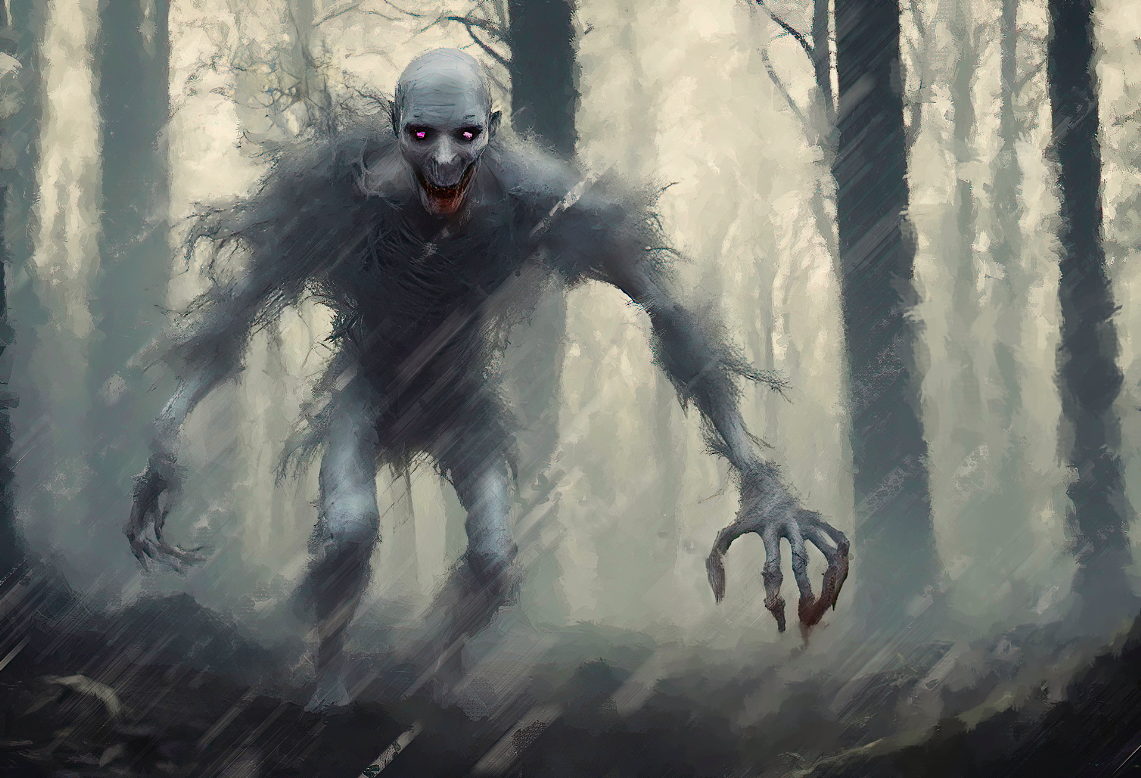
The Wendigo comes from American Algonquian folklore. It is a malevolent spirit that can possess human beings and inflict them with an insatiable hunger that can only be satisfied by eating other humans. It is said to turn their heart to ice, resulting in the possessed person being cold to the touch. While the Wendigo can blend in early during possession, when the possessed person cannot satisfy their hunger, they become gaunt and desiccated.
In modern psychiatry, Wendigo Psychosis is characterized by the desire to eat human flesh and engage in cannibalism.
13. Skin Walkers: Native American Shapeshifters

A skin-walker is a shape-shifting witch from the Navajo tradition. They were once shamans but chose to use their gifts for evil purposes. They can assume the shape of any animal or human they choose to assume their identity, and are also sometimes described as possessing people. The Navajo name directly translates as “by means of it, it goes on all fours” due to its penchant for taking the form of an animal. Whatever shape it chooses, its purpose is always malevolent, and they are considered among the most dangerous Native American mythical creatures.
14. Patasola: Hunting Vampires of Latin American Folklore

The Patasola comes from Colombian folklore and is a female monster that lives in the jungle. It approaches male hunters in the wilderness when they are thinking about women. She appears as a beautiful seductress or even like a loved one of her victims and lures the man deep into the jungle. There, she reveals her true nature as a hideous one-legged creature with an appetite for human flesh and blood. She sucks the blood of her victims dry and then devours their flesh, and they are never seen again.
15. Jersey Devil: Mythical Creature of Modern America

Urban legends from Jersey and Philadelphia report a creature that inhabits the Pine Barrens in South Jersey. It is described in many different ways, but it walks on two legs and has the hooves of a horse, a goat-like head, leathery bat wings, horns, small arms with clawed hands, and a forked tail like the devil. The Jersey Devil can move quickly through the barrens and often lets out a high-pitched, blood-curdling scream. It was apparently the 13th child of a woman in the area who cursed the baby to be a devil during childbirth. There have been many sightings over the years, and in the 1960s, the Philadelphia Zoo offered a reward for the creature.
16. Chupacabra: The World’s Newest Monster?

<p>In 1975, a series of livestock killings in a small town in Puerto Rico was attributed to either a vampire or a satanic cult. But the livestock killings continued, with all the animals bled dry through a series of circular incisions, a new theory emerged. By 1995, these attacks were blamed on chupacabra, which means “goat sucker,” a legendary creature from folklore that drinks blood to sate its insatiable hunger. A reptile-like creature the size of a small bear, it has a row of spines reaching from the neck to the base of the tail. Eyewitnesses report they have seen the creature across Latin America, and a 2019 video may provide further evidence.
